

 HOME | ÍNDICE POR TÍTULO | NORMAS PUBLICACIÓN
HOME | ÍNDICE POR TÍTULO | NORMAS PUBLICACIÓN Espacios. Vol. 37 (Nº 11) Año 2016. Pág. 25
Lara Jansiski MOTTA 1; Renato Ribeiro Nogueira FERRAZ 2; Luc QUONIAM 3; Jesus Paschoal MENA-CHALCO 4
Recibido: 19/01/16 • Aprobado: 30/01/2016
ABSTRACT: This study brings the mapping and analysis of research projects in progress in 2013 in Brazil related to dengue which receive support from development agencies, using the Scriptlattes computational tool, to create the search for results and potential application for control of the disease with the data from the Lattes Platform. The results demonstrated that it is possible to identify projects, considering the information from the records of investigators active in Brazil, besides indicating emergent themes through the analysis and grouping of topics. Prospective studies become a means of support for the analysis of future trends in the prospected area. |
RESUMO: Este estudo, utilizando como exemplo o tema "imunização contra a dengue", e fazendo uso da ferramenta computacional Scriptlattes, traz o mapeamento e análise de projetos de pesquisa em andamento no Brasil no ano de 2013, e que receberam o apoio de agências de fomento. Os resultados apresentados permitiram a realização de uma análise prospectiva sobre o tema, além da identificação de temas emergentes, selecionados por meio da análise e agrupamento de tópicos. Estudos prospectivos como este fornecem um meio de suporte para a análise de futuras tendências em potenciais áreas de pesquisa. |
The funding of Science, Technology and Innovation (ST&I) in the area of health in Brazil is under development and has undergone changes in recent years. Policies for the promotion of ST&I in health are bridging the gap with public health policies, with greater emphasis on the themes of studies considered a priority for the country (Aranha, 2013). However, the furtherance intended for research in the field of current health problems does not guarantee practical application in health policies and services subsequently.
Scientific production is essential in the scientific knowledge legitimation process (Mueller, 2006), and has been studied in depth in different fields of knowledge for some time. Research on the dissemination and use of information generated as a result of scientific research by other sectors of society is a theme that has been gaining relevance due to the public interest it should serve. The prospective analysis of scientific production leads to the understanding of future investment trends and of the development of public policies.
To this effect, it is important to have a description and prospective analysis of projects that receive financial incentive from development agencies with proposals for a solution to public health problems, constituting a tool for investigating the direction of projects and the future possibilities of application, aiming to achieve the desired objectives in each sector and their strategies.
In Brazil, one of the major challenges in the health sector consists of neglected diseases (NDs). This theme is constantly appears on the agenda of investigators, yet scientific production alone is not sufficient to overcome the challenge. Scientific results need to become actions in the planning of public policies. Faced with this issue, the Department of Health (DH) allocates its investments in research guided by the National Agenda of Priorities in Health Research (ANPPS), drafted at the 2nd National Conference on Science, Technology and Innovation in Health, in 2004. This agenda is split up into 24 sub-agendas, and has several research lines related to NDs (Brazil, 2010).
NDs are defined as a set of diseases that besides prevailing in conditions of poverty, also maintain the characteristics of the scenario of inequality. They affect mostly children and contribute to an increase in infant mortality (Ferreira et al, 2009). They are called neglected as they are not the focus of scientific research, especially that furthered by the economic interests of pharmaceutical multinationals. Examples of neglected diseases include: dengue fever, Chagas disease, schistosomiasis, hanseniasis, leishmaniasis, malaria, tuberculosis, and others. According to data from the World Health Organization (WHO), more than one billion people are infected with one or more neglected diseases, which represents a sixth of the global population (Brazil, 2010).
Epidemiological studies of NDs record an alarming number of cases of infection with dengue fever in the world. In the 21st Century there are 112 affected countries, with endemics in Asia, areas of the Pacific, Africa and Latin America. According to Dalbem et al (2014), almost three billion people are at a risk of becoming infected, particularly in tropical and subtropical regions.
Dengue is a viral disease characterized by acute infection, which can develop into a serious condition according to the form in which it appears, namely: classic dengue, dengue hemorrhagic fever or dengue shock syndrome, which can be life-threatening. It is one of the most frequent diseases in Brazil, affecting the population in all states, irrespective of social class (Fonseca et al 2014).
The literature contains historical records of dengue outbreaks (Villela et al, 2013; Silva et al, 2008) and its magnitude should be considered even over the years. However, epidemiologic issues, such as agent, host and environment with biological analysis alone, do not represent the holistic reflection of the dengue epidemic. The biological study should be supplemented by social studies (Villela et al, 2013).
There have also been many efforts related to combating dengue fever in Brazil. Eradication attempts have been proposed and control programs have been created. These include the Aedes aegytpi Eradication Program (PEAa) in 1996 and the National Dengue Control Program (PNCD) in 2002 (Cesarino et al., 2014). These programs advocate the use of legal instruments that facilitate the control of the disease vector and the monitoring and supervision of actions developed by the government agencies in the fight against dengue. However, in spite of some advances, the programs still face problems resulting in inefficient actions, without achieving the proposed targets (Cesarino et al., 2014).
As it has become a public health problem with considerable impact (Villela et al, 2014; Silva et al, 2008), dengue fever is one of the NDs that require constant monitoring and analyses. Thus, this study brings the mapping and analysis of research projects in progress in 2013 in Brazil related to dengue, which receive support from development agencies, to create the search for results and application potential for control of the disease with the data from the Lattes Platform. Master's and Doctoral projects to be finalized in the coming years were considered in this study, thus enabling us to come up with a forecast of the scientific production with results and actions applicable in the next few years for the treatment and control of dengue fever.
For the analysis of research projects in progress in 2013, it was used the Scriptlattes tool to build the pages in HTML format containing the information on a group of Investigators listed and registered in the Lattes Platform. Although it is not possible to gather data directly from the Lattes Platform, a series of computational procedures allows the information from the resumes to be recovered, based on public data made available by the platform itself. Each Investigator registered in the Lattes Platform has a unique record made up of a 16-digit code, known as the ID Lattes, which provides direct access to a webpage where the resume of this Investigator is hosted. For the analysis of projects in progress on the neglected disease "dengue fever", it proved necessary to create text files containing the lists of ID Lattes of all the Investigators, Teachers and students, technicians, and others, who had the above index term in their resumes, in some Research Group in which they were registered, or who had some publication in partnership with the Investigators who fulfilled the previous requirements.
After the creation of the lists posted in Scriptlattes, the operation of the system was basically divided into six sequential modules responsible for processing a certain kind of information extracted from the Lattes Platform. The results furnished by the tool consisted of several reports containing the summarized information relating to the research projects. Specifically for the creation of this study, a simple search by subject was conducted in the Lattes Platform using the index term "dengue", since the advanced search did not return results different from those found with the simple search. Then as a cutoff criterion it was established that the Investigator would have to carry the title of Doctor, regardless of their nationality, and belong to a Research Group with the keyword "dengue" duly recorded in the Research Group directory of CNPq. This allowed to extract the so-called "core competencies" in dengue fever in the country. In a second stage it was verified the identity of the Investigators who had some kind of study in partnership with the Investigators of the core competencies, even if they did not belong to a Research Group with the word "dengue". This group of Investigators was called "level 1 collaborators", or core competencies 1. After the identification of the core competencies 1 investigators the next step was to identify the research projects under the guidance of, or with the participation of, these investigators. After this another filter was added in order to find projects funded by the Brazilian research development agencies. This survey served as grounds for an analysis of the projects, which were grouped by topics selected with a basis on the research themes related to dengue.
In this study, it was used the Scriptlattes tool that allows the standardization and handling of the necessary information for the proposed analysis. Figure 1 illustrates the results of scientific production about dengue in Brazil as an initial background for the subsequent analyses. The homepage in HTML featuring the results with "core competences 1" contains links that lead to the visualization of more detailed analyses, also in HTML, of the investigators, such as technical production and technological products, processes and techniques, and intellectual production. See the "Survey" link that will guide you to the analysis represented by Figure 2.
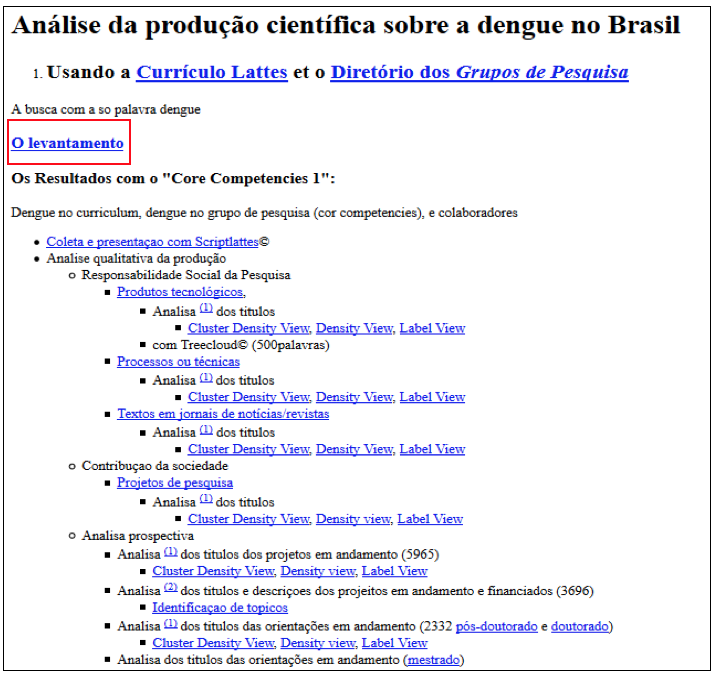
Figure 2 represents the survey according to the criteria that should be contemplated to enable the investigators to belong to "core competences 1" in dengue, following these steps: the investigator should have the index term "dengue" at any point of the Lattes resume and also belong to some Research Group registered with CNPq and with the word "dengue" as one of its index terms. Taking into consideration the above criteria, only 424 Investigators (about 3% of the total group of Investigators who originally had the index term "dengue" in their resumes) were considered to belong to the core competencies in dengue. Investigators with the index term "dengue" in their resume, but in some publication in partnership with the core competencies Investigators (1395 - 424 = 971 Investigators), were considered the "core competencies collaborators", and constituted core competencies 1.
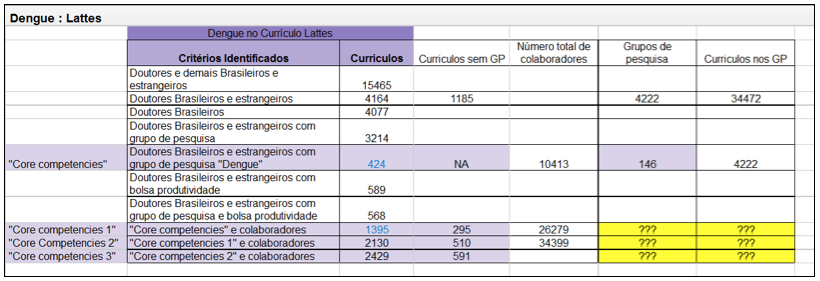
Figure 2: Screen with the survey of the total number of investigators (distributed by category) and of research groups (RG) in dengue active in Brazil. The red frame highlights the link leading to the screen presented in Figure 3.
As regards the range of themes related to the evaluation of competencies in research in Brazil on a particular subject, and related to the extraction, organization and delivery of information about productivity in research, the computational tool Scriptlattes has been widely used not only in relation to dengue (Ferraz et al, 2015; Ferraz et al, 2014a), but also in nanotechnology (Ferraz et al, 2014b) and to evaluate competencies in Stricto Sensu Graduate programs (Ferraz et al, 2014c).
For this study the prospective analysis is highlighted on the initial screen. This analysis is presented by the tool with the analysis of the titles of projects in progress, guidelines of master's theses and doctoral dissertations in progress, and postdoctoral supervisions, as represented in Figure 3. However, as set out previously, the purpose of this study was to analyze projects in progress funded by development agencies.

Figure 3: Screen with the links leading to the main scientific productions of the investigators belonging to core competences 1 in dengue in Brazil. The red frame highlights the productions used for the prospective evaluation of dengue research.
Figure 4 contains the "Identification of topics" link in the "Analysis of titles and descriptions of projects in progress and funded" item, representing the filters for this prospective study. The search for information is used to identify or evidence themes and the relationship between the data identified, and can be used as a tool to support the planning of the performance and funding of academic research (Moreira et al, 2014), besides evidencing the possible future benefits of the investment in science and technology for public health. The Scriptlattes tool allows the analysis of projects in progress, as observed in Figure 4. By clicking on the link correspondingto the "Analysis of projects in progress", it is possible to view the page in HTML containing the master's theses, doctoral dissertations and post-doctorate supervisions in progress.
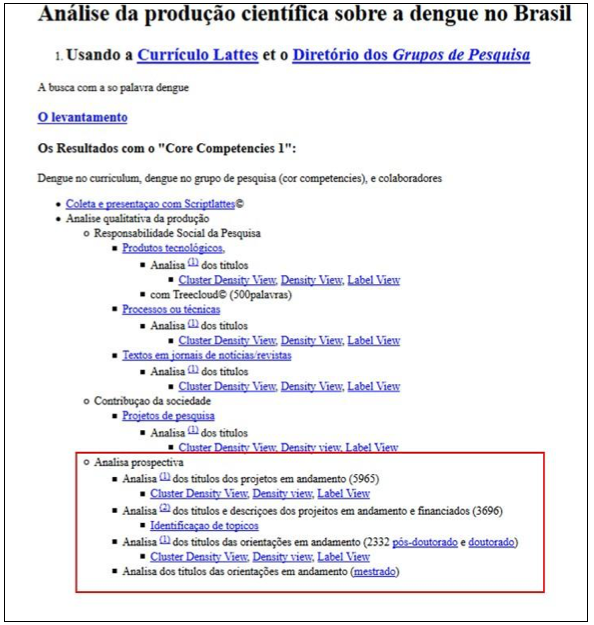
Figure 4: Initial screen highlighting the alternative method of access to the prospective analysis of scientific productions of the investigators belonging to core competences 1 in dengue in Brazil, with special emphasis on projects in progress and funded.
Figure 5 presents the generated pages containing the total number of projects in progress (Figure 5A), postdoctoral supervisions (Figure 5B), doctoral dissertations (Figure 5C) and master's theses (Figure 5D) in progress. Note that the figures contain the graph with the number of guidelines per year, with the title and description of the guided projects appearing below the graph. In this analysis it can be seen that 11216 projects in progress; 382 postdoctoral supervisions; 2193 doctoral dissertation projects and 1834 master's theses in progress were found. However, the projects presented in this analysis were identified by the investigators belonging to core competences 1 in general. This analysis can produce projects related to the investigators, yet not necessarily a dengue research project. It is necessary to perform a further analysis identifying which of the projects are related to dengue. For this purpose, we initially used the Scriptlattes tool to filter the funded projects, and these totaled 3696 studies in progress. This step was followed by the presentation of the analysis through the identification of topics related to dengue research.

Figure 5: Partial presentation of the Total projects in progress (5A), postdoctoral supervisions (5B), doctoral dissertations (5C) and master's theses in progress guided by the investigators of core competences 1 in dengue in Brazil.
Figure 6 illustrates the analysis of the projects, both funded and in progress, by topics generated by the tool. The topics were related to the terms present in the titles and description of the projects, and presented by the tool according to frequency and specificity (Figure 7).

Figure 6: Partial presentation of the projects in progress and funded grouped by topics that are guided by the investigators of core competences 1 in dengue in Brazil.
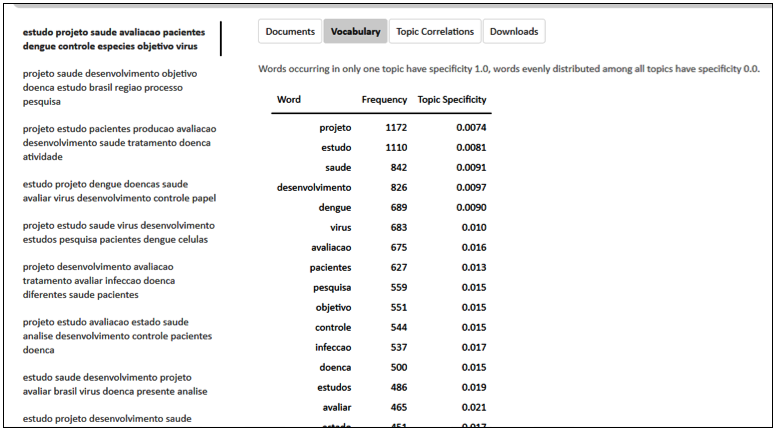
Figure 7: Partial presentation of the analysis of the present terms with regards to frequency and specificity in the topics of projects in progress and funded, grouped by topics that are guided by the investigators of core competences 1 in dengue in Brazil.
Figure 8 exemplifies the analysis of the terms present in the topics, i.e., words that occur in only one topic have specificity 1.0 and terms evenly distributed among all the topics have specificity 0.0. In this study it can be seen that this analysis contributes to identification and reflection in relation to the investment in projects related to dengue. The projects in progress should be transferred in the future from the academic field to public policies and to the industry with the intention of controlling dengue in Brazil. The use of academic searches in dengue allows us to optimize the use of resources earmarked for research in this area, identifying the emergent topics within this theme according to the situational analysis, avoiding financial losses, wastage of time and material, besides identifying opportunities for innovation and technological expansion in the area.
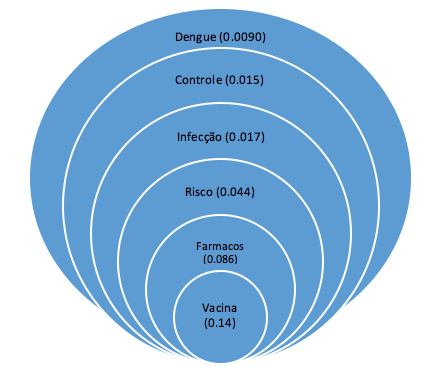
Figure 8: Illustration of the analysis of topics with regards to the specificity of the terms
present in projects in progress and funded grouped by topics that are guided by the investigators
of core competences 1 in dengue in Brazil.
To exemplify the use of the Scriptlattes tool to support the planning of academic research and furtherance, after the analysis of topics, the dengue-related theme "immunization" was selected. A total number of 17 funded projects in progress were identified in this topic. As described in Table 1, the funded projects in this theme can be seen to have increased from 2010 to 2013, while the year of this study had the highest number. This configuration is believed to be related to the difficulties faced by anti-dengue programs in Brazil and the persistence of the disease's occurrence nowadays in the country. It should take into consideration the fact that these analyzed projects were identified by the search and analysis of scriptlattes, whose base consists of the lattes resumes of each investigator according to the core competencies. This implies that some inadequate fulfillment of requirements by the investigator may have entailed the non-identification of the project for this analysis.
As regards the academic level, note that the Postdoctoral projects were identified in a smaller number considering the projects linked to the Doctoral dissertations and Master's theses.
Investments in public health research should cover both the induction of the generation of scientific and technological knowledge and new tactics for the formulation of public policies, involving health professionals and the producers of inputs for the health system, considering the needs of the population. In view of this scenario, it is important to analyze the themes addressed by the research projects to reflect on the conformity between research and current needs (Aranha, 2013). The choice of the theme "dengue" for this study on searches for scientific production is due to the relevance of the disease from the point of view of public health in Brazil and other parts of the world, as well as the problems that should be faced for their control (Villela, 2014). Dengue fever is considered a neglected disease as it is does not appear very often in scientific research, especially that furthered by the economic interest of pharmaceutical multinationals, yet there is a perceptible opportunity for growth of Brazilian production in research related to this theme that can influence local and global policies for fighting dengue. When using research on this theme as an example of prospective analysis of Brazilian scientific production, there are a significantly large number of investigators and projects involved in the topics of vector controls, disease monitoring, epidemiological studies, diagnostic tests, clinical surveys, and currently vaccines against dengue. The topic of immunization appeared as an emergent topic, since several strategies have been drawn up for the production of vaccines against dengue, yet it is still necessary to improve the immunogenicity of the antigens (Bizerra, 2014), denoting the importance of these projects in progress focused on this topic, as well as the refinement of drugs and the studies on the effectiveness of disease control through immunization covering the entire population. With the performance of this prospective analysis, projects promoted from 2010 to 2013 are expected to produce results that can contribute to this improvement and produce proposals of studies evaluating the effectiveness of immunization against dengue in places where the disease is highly prevalent.
The main goal of this study, through the example of the theme immunization against dengue, was to show how the use of the Scriptlattes tool can support the prospective analysis of academic production and the planning of the furtherance of research in a particular area of knowledge. The results demonstrated that it is possible to identify projects in progress and funded, considering the information from the records of investigators active in Brazil, the Platform Lattes, systematically, besides indicating emergent themes through the analysis and grouping of topics. Prospective studies become a means of support for the analysis of future trends in the prospected area. In this example, the studies related to the refinement of drugs for immunization lead as a next step to the need to verify the efficacy of such drugs, with this theme constituting a tendency for future projects. Moreover, this prospective outlook allows the identification of opportunities for partnerships between companies and research centers, besides the support of government agencies that promote research. In view of the above, this article is expected to bring about the dissemination of the importance of academic searches and particularly the applicability of the Scriptlattes tool for information gathering in the academic base. This tool is helpful mainly in the compilation of data from the Lattes resume, which is usually hard to collect manually. Although automatically demonstrating the obtainment of data, the results reflect only what is registered in the Lattes Platform. It is important to keep in mind the need for tools that can assist in studies concerning academic production for better development and performance of research projects and their future applications.
Aranha, S. C. A. D. (2013). Estudo sobre o fomento à pesquisa em dengue no Brasil: contribuições para a aproximação entre a geração e o uso do conhecimento. (Unpublished doctoral thesis). University of Brasilia, Brasilia, Brazil.
Bizerra, R. S. P. (2014). Desenvolvimento de uma vacina de subunidade contra o sorotipo 2 do vírus dengue baseada no domínio helicase da proteína NS3 (Doctoral dissertation, Universidade de São Paulo).
Brasil (2010). Doenças negligenciadas: estratégias do Ministério da Saúde. Rev Saúde Pública, 44(1), 200-2.
Cesarino, M. B., Dibo, M. R., Ianni, A. M. Z., Vicentini, M. E., Ferraz, A. A., & Chiaravalloti Neto, F. (2014). The difficult interface between vector control and primary care: insertion of dengue fever vector control agents into health teams at the primary health centers in São José do Rio Preto, São Paulo, Brazil. Saúde e Sociedade, 23(3), 1018-1032.
da Silva, L. J., & Angerami, R. N. (2008). Viroses emergentes no Brasil. SciELO-Editora FIOCRUZ.
Dalbem, A. G., Herling, J. D., Vieira, R. G., & de Souza, V. A. I. (2014). Dengue clássica e febre hemorrágica da dengue: etiologia, fisiologia, epidemiologia e fatores de risco. Revista Ciência e Estudos Acadêmicos de Medicina, 1(01).
Ferraz, R. R. N., & Quoniam, L. (2014)b. A utilização da ferramenta computacional Scriptlattes para avaliação das competências em pesquisa no Brasil. Revista PRISMA. COM, (21).
Ferraz, R. R. N., Quoniam, L., & de Rezende Alvares, L. M. A. (2014)a. Avaliação de redes multidisciplinares com a ferramenta Scriptlattes: os casos da nanotecnologia, da dengue e de um programa de pós-graduação Stricto Sensu em Administração. Encontros Bibli: revista eletrônica de biblioteconomia e ciência da informação, 19(40), 67-98.
Ferraz, R. R. N., Quoniam, L. M., Maccari, E. A., & da Silveira, V. O. (2014)c. Análise e gestão de análise de redes de colaboração entre pesquisadores de programas de pós-graduação stricto sensu com a utilização da ferramenta computacional Scriptlattes. Perspectivas em Gestão & Conhecimento, 4, 133-147.
Ferraz, R. R. N., Quoniam, L., Pimenta, D. N., Mena-Chalco, J. P., & Nigro, C. A. (2015). Extração e disponibilização on line de indicadores de desempenho e prospecção dos resultados das pesquisas em dengue com a utilização da ferramenta computacional Scriptlattes. Encontros Bibli: revista eletrônica de biblioteconomia e ciência da informação, 20(43), 93-114.
Ferreira, H., Lala, E. R. P., Monteiro, M. C., & Raimondo, M. L. (2009). Estudo epidemiológico localizado da frequência e fatores de risco para enteroparasitoses e sua correlação com o estado nutricional de crianças em idade pré-escolar. Publicatio UEPG: Ciências Biológicas e da Saúde, 12(4).
Fonseca, I. S. S., de Jesus, S. R. R., & da Silva, E. M. (2014). Epidemiologia da Dengue no Brasil no ano de 2012. Caderno de Graduação-Ciências Biológicas e da Saúde-UNIT, 2(2), 69-78.
Mueller, S. P. M. (2006). A comunicação científica e o movimento de acesso livre ao conhecimento. Ciência da Informação, Brasília, 35(2), 27-38.
Villela, E. F. D. M., & Almeida, M. A. D. (2013). Social representations of dengue: reflections on the mediation of information in public health. Saúde e Sociedade, 22(1), 124-137.
Villela, E. F. D. M., & Natal, D. (2014). Media, health, and power: a game of representations on dengue fever. Saúde e Sociedade, 23(3), 1007-1017.
1. Programa de Mestrado Profissional em Administração – Gestão em Sistemas de Saúde (PMPA-GSS), Universidade Nove de Julho (UNINOVE), São Paulo, SP, Brazil. Corresponding author. Email: larajmotta@terra.com.br
2. Programa de Mestrado Profissional em Administração – Gestão em Sistemas de Saúde (PMPA-GSS), Universidade Nove de Julho (UNINOVE). Programa de Pós-Graduação em Administração (PPGA), Universidade Nove de Julho (UNINOVE), São Paulo, SP, Brazil.
3. Programa de Pós-Graduação em Administração (PPGA), Universidade Nove de Julho (UNINOVE), São Paulo, SP, Brazil.
4. Programa de Pós-Graduação em Ciência da Computação. Universidade Federal do ABCC, Santo André, SP, Brazil